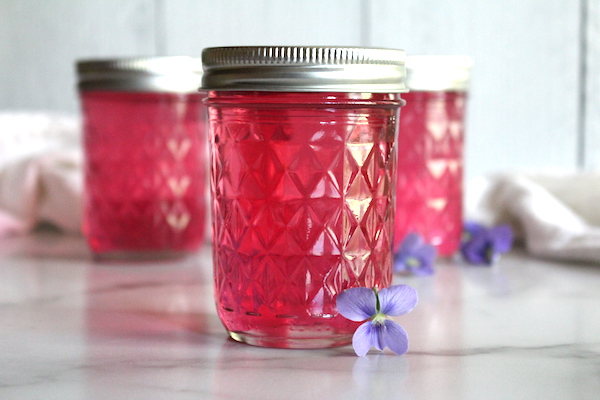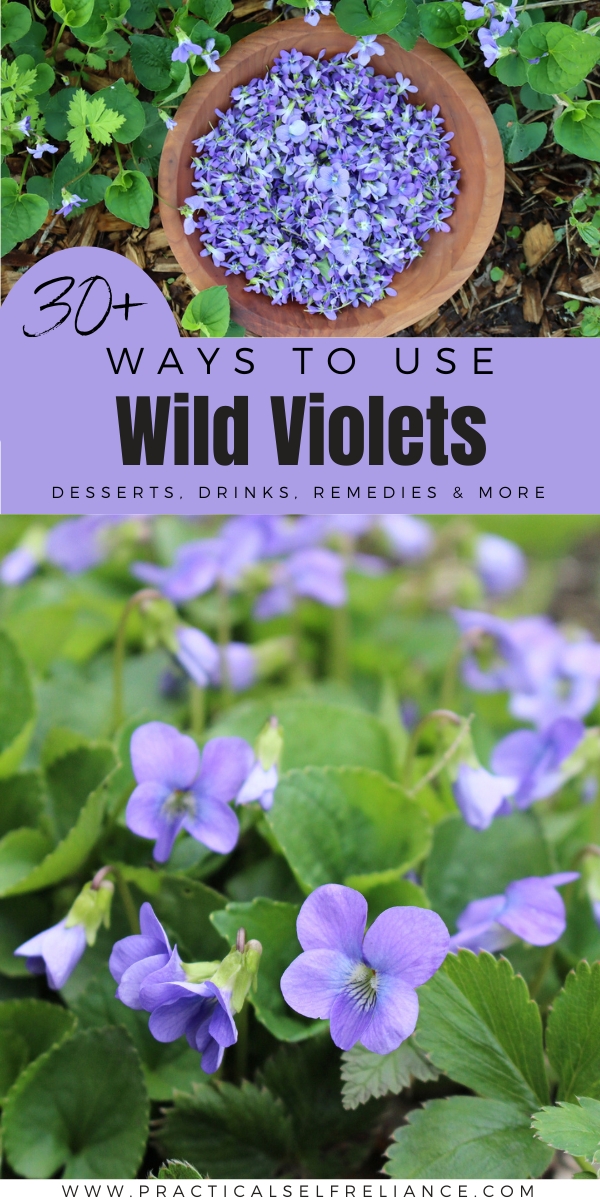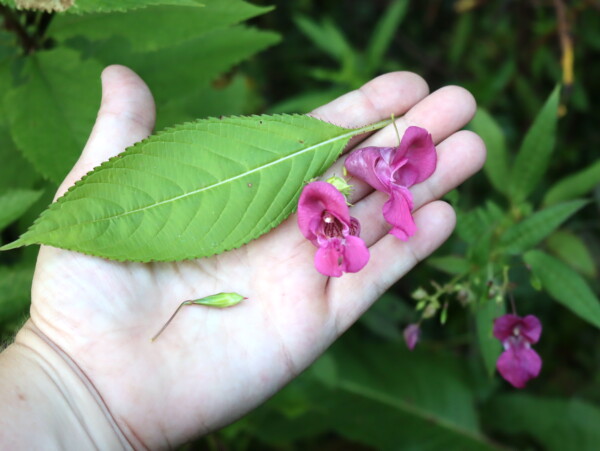Affiliate disclosure: This post may contain affiliate links. Please see our Privacy Policy.
Wild violets are edible flowers with endless uses, and they also have medicinal properties. Learn how to use both wild violet flower, as well as leaves, for food and medicine.

Wild violets carpet the ground each spring on our shady, wet Vermont soil. They’re a cool-season flower, and they really thrive before temperatures warm later in the summer.
In the warmer sunny spots, they’ll pop up right alongside dandelions early in the spring. In cooler parts of the yard, under the shade of our apple trees, they’ll grow lush and green and bloom well into the summer season.

Wild violets grow all over the US, but their abundance really depends on your soil type. If you have sandy dry soils, don’t expect to find them anytime soon. They need heavier soils that hold moisture to thrive. A little shade helps too.
You can create a microclimate for them in containers, even in the middle of the desert, by growing them in rich potting soil on a shady patio. My mom has a thriving planter of “wild” violets in the Mojave Dessert, all propagated from violet root divisions.
Given the right conditions, wild violets are incredibly common. If you’re foraging them in the wild, always be 100% certain about your identification before consuming them (though they have no close look likes). Here’s how to identify wild violets.

Wild Violet Medicinal Benefits
While wild violets are tasty and add color and excitement to all manner of recipes, some of their best uses are actually in the medicine cabinet rather than the kitchen, at least when it comes to their leaves.
Wild violet flowers are a mild diuretic, but only mildly. They’re best used to add color and flavor to dishes, and when infused into a tea (or made into a jelly) the blossoms taste like fresh summer berries (think blueberries and raspberries).
The leaves, however, are a lymphatic tonic, and they’re used topically and internally to promote lymphatic health. Women use wild violet leaf lotions and salves to treat fibrocystic breasts, and the leaves can be added to herbal deodorants where they’ll promote lymphatic health as they’re applied to lymph-rich armpits.
Those same lotions and salves also help with lymphedema on the extremities.
Violet leaves with other topical issues as well, and they’re used to treat inflamed skin, rashes, hives, and eczema.
As a tincture and tea, the leaves still act on lymphatic issues internally, but they’re also taken to improve digestion and sore throat and cough. The leaves contain substantial amounts of mucilage, which is exceptionally soothing to the whole digestive and upper respiratory tract.
You can taste the mucilage when you eat fresh violet leaves in a salad, and some people note that they’re a bit “gummy.” If you’re making a salad with violet leaves, start with a small amount mixed in with tender spring green to see how you like it. (Some people love whole bowls of violet leaf salad, but it’s not for everyone.)

Ways to Use Wild Violets
Since both the flowers and leaves are edible and medicinal, I’m going to cover violet recipes for both parts.
Wild Violet Flower Recipes
For the most part, violet flowers are used in sweet drinks, desserts, and preserves.
There are a few exceptions where they also make their way into savory meals.
Violet Desserts and Sweets
The berry-like flavor of wild violets really shines in muffins, jelly, cookies, and candied flowers.

Wild Violet Drinks
Wild violets also make excellent drinks, lending both their vibrant color and wonderful flavor.
A simple violet syrup can be combined with mixed drinks, or just a bit of seltzer for a quick violet soda. Or, you can get advanced and make violet kombucha, or even violet wine!
- Violet Flower Syrup
- Violet Lemonade
- Violet Kombucha
- Violet Tea
- Violet Moon Milk
- Violet Liqueur
- Edible Flower Wine (with any Flower)

Savory Wild Violet Flower Recipes
The natural acidic nature of vinegar brings out wild violet flowers’ color (and flavor).
They’re often used in salad dressings but can also be made into pickled flowers!
- Violet Vinegar (for vinaigrette)
- Wild Violet Vinaigrette
- Pickled Violet Flowers

Wild Violet Leaf Recipes
The leaves of wild violets are usually reserved for savory recipes, and they can be used anywhere you’d use spinach or kale. I hope to make a violet leaf spanakopita this year with abundant wild violet leaves wrapped in tender phyllo dough.
Violet leaves can be used raw, or cooked.
- Wild Violet Salad (leaves and flowers)
- Violet Leaf Pesto
- Violet Greens Soup
- Violet Greens Gomae (Japanese Violet Salad)

Wild Violet Medicinal Preparations
Externally, violet leaves are used to promote lymphatic health and for minor cuts, scrapes, rashes, and burns.
Internally, they’re used to soothe the digestive system and treat cough, sore throat, and upset stomach.
The flowers are also used for their internal and external soothing properties.
Flowers
Leaves
- Violet Skin Cream for Lymphatic Health
- Wild Violet Salve
- Violet Infused Oil
- Natural Violet Deodorant (with lymphatic Benefits)
- Wild Violet Tincture for Cough
- Violet Cough Syrup
This is just the beginning, and violets can be used in dozens of types of herbal preparations. I’ve yet to see any specific recipes for violet oxymel, poultices, capsules, or glycerites…but that doesn’t mean you can’t make them!
Ways to Use Edible Flowers
Looking for more ways to use edible flowers in your kitchen and herbal medicine cabinet?
- 60+ Ways to Use Dandelion Flowers
- 50+ Lilac Recipes
- 50+ Ways to Use Edible Roses
- 30+ Ways to Use Peonies
- 60+ Elderflower Recipes





Hi Ashley. Thank you for all of the valuable information and your wonderful website.
I have been looking everywhere for wild violet seeds and cannot find any. Can you recommend a place? Thank you and God Bless you and your family.
The only place I’ve ever seen them is on etsy. The problem with the seeds is the above ground flowers are sterile, and they mostly set seeds below ground (strange I know). They’re transported by insects, that’s how they spread. It’s really tricky to get actual seed. However, you can get wild violet plants or cuttings and they do really well. I’d recommend looking on etsy for plants. Best of luck!